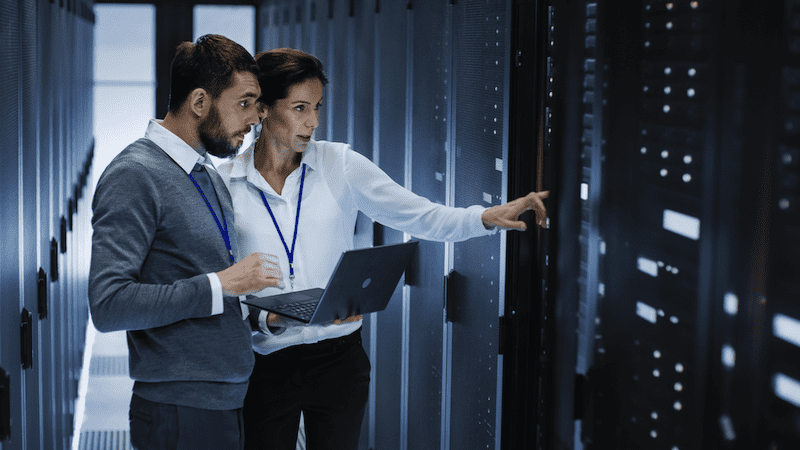Numerous companies use IT systems that can be susceptible to internal and external cyber-security breaches. These threats demand the utilisation of data centre security in businesses.

In 2018, My Fitness Pal's social media app suffered a cyber-security breach leading to the public exposure of approximately 150 million users' email addresses, IP addresses, and login credentials such as passwords. My Fitness Pal proceeded to work out the nature and scope of the breach, notify users, and collaborate with data security firms to protect their IT systems. Such incidents of cyber-security threats have increased in today's data-driven lifestyle. As companies shift to digitisation, there is a growing need for data protection systems. One of the ways of protecting sensitive and confidential data is implementing data centre security in business operations.
What is Data Centre Security?
Data centre security refers to the physical and virtual solutions used to protect a data storage facility against external and internal attacks. A data centre is a facility composed of networked computers that organise, analyse, and store data. They are beneficial for companies as data centres minimise setting up personal centralised networks and servers. Data centres usually store private and classified data. Therefore, data centre security is required to protect its physical and virtual infrastructure against potential threats.
Must Read: A Comprehensive Guide to Data Center Infrastructure Management (DCIM)
What are the Major Data Centre Security Problems?
Reliable data centre security standards require analysing issues that may affect data protection held at a data centre. These problems involve both the physical and virtual spheres of data storage.
Physical access to the building
There are several factors to consider while establishing physical safety measures of the data centre. These include scrutinising the security measures set in place to access the data halls, the possibility of unauthorised personnel entering the facility, and the systems used to track movement inside the facility.
Access to data
This factor considers how secure the data is against cyber-attacks by hackers. The data centre should use up-to-date firewalls and protection systems. The physical security of the data is also paramount.
Data protection
Data centres safeguard data in compliance with privacy and regulatory standards. The data centres should also ensure the quick recovery of data in case of hardware failures.
Redundancy
Redundancy is defined as creating duplicate backup equipment and links that immediately take over in place of malfunctioning equipment. This measure ensures that the data storage systems are not affected by unexpected power outages and equipment failure.
Solutions for Data Centre Security
Any vulnerable data centre component can be an entry point for data breaches. These breaches can occur through insecure physical or digital access points. Therefore, in data centre design, every detail varying from networks to physical infrastructure corresponds with the highest data centre security standards. The following is a comprehensive data centre security checklist on physical and virtual aspects of data security.
-
Physical data centre security standards
The provision of a secure location is key in data security. There are several factors to consider in the architecture of data centres, including climate protection, seismic activity, terrain, and natural disasters. Therefore, several data centre colocation providers now opt to construct underground facilities equipped with an all-encompassing security strategy.
Underground data centre facilities should demonstrate consistent maintenance and monitoring of their internal environmental conditions. These conditions include effective cooling mechanisms, natural airflow, protection against the elements, and real-time air quality monitoring.
Moreover, physical security includes limiting possible entry points to reduce the risk of break-ins. Data centres have one main entrance for clients and employees and one back entrance for loading docks. These measures control the physical access to the building.
Barriers are essential components of the data centre's physical security. These include fences, concrete walls, and landscaping. Windows fitted with laminated glass are restricted to break rooms and administrative offices.
- Virtual data centre security features.
Data centres have multi-factor authentification security options. The numerous checkpoints utilised to access data equipment may involve checking in using an official ID, a visitor's badge, biometric access, facial or retinal scans, a cage key, and a specific badge key card to access private locations.
These facilities are also fitted with the latest, high-resolution video surveillance systems for additional security. A technician always monitors the video to provide real-time information on suspicious activity.
Furthermore, data centres are designed with redundancy in mind to ensure minimal downtime during unprecedented equipment failures. Data centres are fitted with multiple resources for utilities such as power, electricity, cooling, and networks.
FAQs
- What are the data centre tiers?
Data centres can be classified into four tiers graded from I to IV. The Uptime Institute's Tier Certification determines the data centre's rating. It decides the criteria used in each tier and evaluates the standards used to classify tiers. Key factors considered during rating include performance, technology level, and technology brand. Tier I and Tier II are cost-effective options for small businesses. However, Tier III and Tier IV provide extensive redundancy services.
- Why do data centre colocation providers prefer underground locations?
Physical data security is crucial for data protection. Underground locations with an all-encompassing security strategy are the safest places to build data centres.
- What can data centre security tools be implemented in data centre facilities?
Several tools promote physical and virtual safety. These include video surveillance, limited access points, 24-hour security, and biometric technology.
- Why is a data centre's security important?
Data centres store sensitive and proprietary information, including customer information. Cyber-security attacks may lead to the public exposure of this confidential information compromising the client's security and the business' reputation. The relevance of data centre security is emphasised as it encompasses various policies, procedures, and technologies that prevent internal or external cyber-security threats.
Conclusion:
Data centres play a crucial role in the digital transformation of businesses. Their services include data storage, backup and recovery, management, and network formation. Data centres are a goldmine of information. This information is highly sensitive as it may include consumer information. Therefore, data centre security is the physical and virtual protection against potential cyber threats. Nxtra, India's largest network of data centres, creates a platform for businesses to design and operate their personalised, strategic digital plan. It facilitates the digital transformation of organisations through reliable, borderless, and customer-oriented IT infrastructure.
Nxtra by Airtel, a subsidiary of Bharti Airtel Limited, offers
largest network of secure, scalable, and sustainable data centers
in India to leading enterprises, hyperscalers, start-ups, SMEs
and governments.
Follow us on :






_1724410758.jpg)
